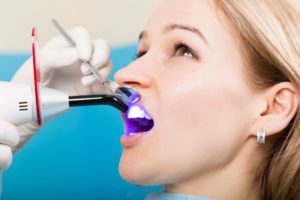 There once was a time when the only method to restore decayed teeth was with metal fillings. Since the emergence of direct bonding nearly two decades ago, though, patients have had a more aesthetically-pleasing alternative. With the advancements that have been made in their fabrication and application, direct bonds can last 10 years or more. As you read on, your cosmetic dentist in Plainview explains some of the improvements that have been made.
There once was a time when the only method to restore decayed teeth was with metal fillings. Since the emergence of direct bonding nearly two decades ago, though, patients have had a more aesthetically-pleasing alternative. With the advancements that have been made in their fabrication and application, direct bonds can last 10 years or more. As you read on, your cosmetic dentist in Plainview explains some of the improvements that have been made.
What are Direct Bonds?
A direct bond is an application that straddles the lines between cosmetic and restorative dentistry. The tooth-colored resin compound helps to rebuild damaged enamel to restore its look and function by adhering directly to the teeth, and patients are able to be fully restored in just one visit.
A New Generation
The direct bonding technique first emerged in 1956 and has gone through several improvements (called generations) since. Now in its eighth generation, a new form has emerged called universal adhesives. With this advanced method, the bonding agent is packaged in a single-bottle solution that performs the following the three tasks:
- Etching – The solution contains a small amount of phosphoric acid that roughens the surface of the teeth to allow the bonding agent to adhere properly.
- Priming – After the tooth has been etched, the next step is to prime the dentin layer just a person would before applying paint to a wall.
- Bonding – The final step is for the resin compound to adhere to the tooth, leaving an aesthetic yet functional restoration.
The Benefits of the Eighth Generation
Whereas bonding to enamel has historically been a rather simple process, adherence to the more sensitive dentin layer has presented some challenges.
A key feature of the eighth generation of direct bonds is that they reduce the amount of water left after application by being more responsive to evaporation. The result of having less water present is that the bonds adhere better, which contributes to less sensitivity.
Are They Right for You?
To learn more about the recent advancements in direct bonding and to see if this method will work for you, reach out to your dentist in Plainview to schedule a consultation. While there, the professional will examine your teeth to evaluate your current condition. He or she will then work with you to develop a plan of action so that you can be restored in the most effective and aesthetically-pleasing manner possible.
About the Author
Dr. Miguel A. Cansanas Jr. earned his DDS degree from the State University of Stony Brook. In addition to being a practicing dentist, he has also worked as an associate professor in the past. To stay abreast of the latest changes in the complex world of dentistry, Dr. Cansanas maintains membership in several professional organizations, including the American Academy of Cosmetic Dentistry. He practices at Meadowbrook Dentistry, and he can be reached for more information through his website.

